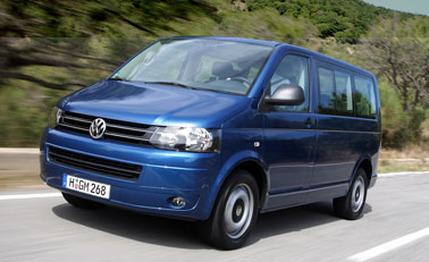
 First Drive Review
First Drive Review
One of the unforgotten vehicles of VW’s past is the Microbus, the hippie-totin’ love bus of the 1950s through ’70s. Its successor, the still-rear-engined Vanagon, was sold here until the early ’90s.
A Historic Figure
The Vanagon was succeeded by the EuroVan, internally called the T4 and sold in the U.S. off and on until 2003, which switched to a front-engine, front-wheel-drive layout. Not exactly blessed in the looks department, the boxy EuroVan never managed to assemble the cult-like following of its predecessors. But in Europe, it soldiered on and morphed into the T5, or Multivan, which is available with an optional 180-hp, 2.0-liter twin-turbocharged diesel four-cylinder, an optional seven-speed dual-clutch automated manual transmission, and 4MOTION all-wheel drive.
From the outside, the current T5 has not deviated far from the T4 EuroVan. Its dull and boxy shape received a few upgrades last fall to bring it up to Walter de’Silva’s edgy new styling that’s spreading across the VW lineup—the large T5 confirms that the look works better on smaller cars. But the practical virtues of the T5 are undisputed. This is a sizable van, with far more room than your regular minivan would offer—and this includes the Routan, VW’s own variation of the Chrysler Town & Country. The Multivan is taller than a minivan, and behind the wheel you never forget it. You sit tall and proud, and—if you have them—it will bring back memories of childhood trips in conversion vans.
The Upscale Box
The level of refinement, on the other hand, is far beyond that of any other vehicle offered in this class. The attention to detail and the material quality are high. There are blue entry lights, the instrumentation is executed in cold white with red needles, and there is a sporty three-spoke steering wheel. The shifter is placed conveniently close to the wheel but is not mounted on the column as in Grandpa’s van.
VW offers only one gas engine: a 2.0-liter four-cylinder producing 115 hp. (The pre-face-lift 3.2-liter VR6, a smooth unit with a considerable appetite for fuel, has been discontinued.) By far the most popular engine is the 2.0-liter TDI diesel, which comes in four versions: three single-turbo variants with 84 hp, 102 hp, and 140 hp; and a twin-turbo with 180 hp. The latter also makes a hearty 295 lb-ft of torque at 1500 rpm.
More Capable Than You Might Think
The switch from pump-injector to common-rail fuel injection has made the TDI much quieter than before; what you hear now is a pleasant purr. The previous top-of-the-line diesel, a 2.5-liter five, won’t be missed. The Haldex all-wheel-drive system in the 4MOTION version that we drove has been upgraded with an electric pump and electronic management. Combined with the seven-speed Direct Shift Gearbox (DSG), which replaces the previous conventional six-speed auto, this combination of state-of-the-art technology translates into an excellent 27 mpg in the European cycle. Front-wheel-drive models with the 84-hp TDI are rated up to 32 mpg.
Despite the high seating position and center of gravity, the Multivan 4MOTION handles well; the Multivan probably can outrun your average minivan in the twisties. Body roll is kept to low levels, and the steering is sensitive, although we wish it were more direct. Seventeen-inch wheels are standard, but we like the optional 18s even better.
The Multivan’s domain is the autobahn, however, where it can cover long distances with remarkable poise and celerity. According to the numbers, this van is no racer. Our all-wheel-drive tester with the DSG and 180-hp TDI diesel is claimed to run from 0 to 62 mph in an unimpressive 12.1 seconds, with an ungoverned top speed of 117 mph. But with its torquey character, it maintains speed even on long uphill stretches and never feels underpowered. The combination of performance and mileage is remarkable for a van of this size.
So are its off-road credentials. The all-wheel-drive system reacts quickly if loss of grip is detected and can shift 100 percent of the power to the front or rear.
Another Forbidden Fruit
The Volkswagen Multivan was not developed with U.S. requirements in mind because the plan was to offer us a new Microbus, which was to be to the original bus what the New Beetle is to the original Beetle. The new Microbus was being developed simultaneously with the T5, and it was created under Piëch and design chief Hartmut Warkuss. But it fell victim to former CEO Bernd Pischetsrieder’s and former chief designer Murat Günak’s wish to leave their own stamp on the brand. The Microbus did not reflect the fussy, chrome-laden styling Günak had in mind, and the program was killed in 2005.
The Multivan 4MOTION is probably the most versatile and most technologically advanced of vans. Unfortunately, it also is the most expensive. The 180-hp 4MOTION with the DSG that we drove costs the equivalent of about $70,000 in Germany; base models with the wimpy gas four-cylinder or base TDI engine start at just above $40,000. (With these prices, you can see why the Routan exists.) Volkswagen is probably well advised to hold off on launching a fully VW-engineered U.S.-market van until it can be done affordably and with more style.